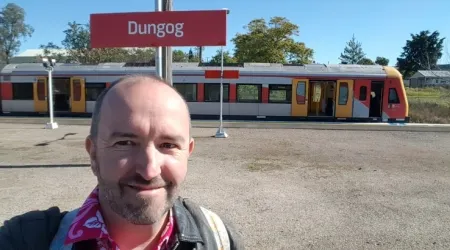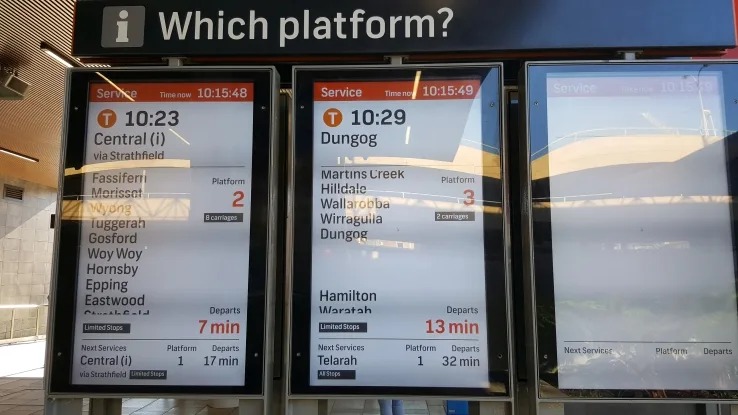Trainfinder Newcastle: Travelling every train line in a single day


Only two branches, but almost 500km of travel.
Throughout 2018, Angus Kidman is undertaking the Trainfinder challenge, visiting every city in Australia and New Zealand with a suburban rail network and travelling across the length of every line in a single day. Learn about why he's doing it and what's involved.
Newcastle was a late addition to Trainfinder. My plan was only to cover suburban networks, which meant that trans-urban lines connecting back to the capital, like the Sunshine Coast line in Brisbane, weren't included. The same logic applied to Intercity Trains, the brand Sydney Trains uses for its farther-flung services to places like Wollongong, Bathurst and Newcastle.
However, while most Intercity Trains services run to Sydney Central, there is one exception: the Hunter Line. That travels from Newcastle Interchange through Maitland to Telarah, with occasional extensions to Scone and Dungog. None of those trains ever make it into Sydney; even the maintenance depot is at Broadmeadow.
Before the coming of the Opal Card, there were separate travel passes that only covered the Newcastle region. Heck, it even has its own entirely separate map in the train carriages.

The evidence is clear: the Hunter Line is an independent Newcastle/Maitland suburban service, not a Sydney feeder, and that meant I needed to cover it.
How much train travel are we talking here?

The vast majority of Hunter Line services travel from Newcastle Interchange west through Maitland (notable as Australia's only regional town with four separate active railway stations) and terminate at Telarah. That service runs every half-hour or so for most of the day.
However, five times a day in each direction there's an extension service to Dungog (some 82km from Newcastle Interchange) and three times a day a train branches at Maitland and runs to Scone (163km away). These are regular services you can pay for with an Opal card, distinct from the occasional XPT and Xplorer country trains that also run through those stations (Scone is on the Armidale/Moree branch, Dungog on the North Coast line).
I did the day trip to Scone and back as part of my Ultimate Opal Hack back in 2016 (and I also tried a midnight version of the same trek in 2014). Today poses a different challenge: covering both branches in a single day.
While one line with two forks is the simplest network I'll face for Trainfinder, it's far from the shortest. In total, I'll be travelling around 490km (not including getting to Newcastle in the first place). Compare that to Adelaide, where travelling the entire network of half-a-dozen lines covered just under 240km.
Pedant note: for much of the day, smaller stations between Newcastle and Gosford (like Dora Creek) don't have a direct service to Sydney, with passengers having to change at Gosford. However, in the early morning and late evening, there are true all-stations services that stop at every destination from Newcastle to Sydney Central. As a result, I decided this segment didn't count as a separate Newcastle-only branch line for documentary purposes (even though I did have to travel on it to get to Newcastle in the first place). Hey, it's my challenge. Let's hit the rails!
Newcastle Interchange-Dungog 10:29am-11:50am

Most Trainfinder journeys began in the very early morning, but since I had to get to Newcastle first, this one officially begins at 10:29am. That means no peak hour fares, and also nothing resembling a commuter crowd.

The staff at Newcastle Interchange don't want you getting confused. Not only are there indicator boards outside the station and on each platform, but giant yellow signs reassure you about which train you need to board.

Hunter Line services run using two-car Hunter trains (and occasionally older Endeavour models). These have relatively modern Tangara-like seating (two on one side, three on the other), and also a toilet, which isn't unacceptably feral when I check it out.

The Hunter was the first area in Australia to deploy railways, so there are multiple tracks and plenty of freight trains along much of the route. However, much of the route is entirely uninhabited.

As I'd expected, a lot of passengers exit by the time we get to Maitland. At Dungog, where we land dead on time, there are just four people who alight.

Given its regional obscurity, Dungog has enormous platforms. It originally had just one island platform, but when it was enlarged in 1944, the planners really went to town. Despite this, the step from the train to the platform is one of the biggest I've seen for a suburban service in Australia.

While the train's waiting in the platform to return, an XPT service (originating from Grafton) stops off as well. This effectively constitutes rush hour at Dungog.

Oddest station name on this line: Mindaribba. It's also worth mentioning because the entire platform is just one train door wide, as you can see in this video I shot quite a few years ago. Four stations on this line (Hilldale, Mindaribba, Wallarobba and Wirragulla) have this configuration; apparently it makes for cheaper maintenance.
Dungog-Newcastle Interchange 12:26pm-1:45pm

The most notable feature of the return trip is the random scraps of dialogue from the handful of passengers on board:
- "One of me mates just moved to Boggabri."
- "Yeah, the doors shut when the train moves."
- "You think you're drunk now."
In theory, I could get out at Maitland, which is the station where Scone trains diverge. In practice, there's such a long wait until a Scone train runs that it makes more sense to return to the livelier surrounds of Newcastle Interchange.
Newcastle Interchange-Scone 4:29pm-6:24pm

And so, some two-and-a-half hours later, it's time to head to Scone. The signs are helpful, but don't point out that we have to board the far train on the platform (an affliction which Newcastle has maintained even when the station was relocated).

The train isn't full, but there are a decent number of passengers on board, far more than I remember from the last couple of times I travelled on this line. More than half of them stay the course beyond Maitland, reflecting the fact that this is the peak-hour commuter service for Scone.
We're travelling through Hunter wine country, but it's getting dark so there's not much chance to enjoy the view. While this line sees fewer services than Dungog, it actually has more elaborate stations, with platforms for each direction. Most passengers stick it out all the way to Scone itself, though.

Badly behaved commuter note: while this represents the northernmost Opal card point in NSW, I don't see anyone tapping out. Given that Newcastle Interchange is the only station on this line with access gates, it would be easy to dodge fares.

The train parks itself at the southern end of the platform, rather than near the exit. There's a reason for this: that end is raised for accessibility.
Oddest station name on this line: Branxton (shades of "Un-Break My Heart", yes I know the spelling isn't an exact match, gimme a break, don't leave me out in the rain).
Scone-Newcastle Interchange 7:06pm-9:00pm

While the train has a 40-minute turnaround, passengers start boarding from a good 25 minutes before it leaves. I guess when there are only three trains a day, you don't want to miss one.

What's notable about this return trip is how many people seem to be using it as a local service, hopping off at stations before Maitland. I'd have figured most people getting on board would keep going to Newcastle Interchange, but when I eventually get off, there is only one other passenger.
What I learned

Not many people would spend seven hours on trains just to say they had been to Scone and Dungog on the same day, but there's clearly a local appetite for these services. Indeed, it's tempting to speculate that they might be more widely used with more services. However, given the small populations of each town (Dungog has around 2,400 residents, Scone 4,600), that seems unlikely. It is odd that Scone, the larger town, has fewer trains.

It's also a surprisingly cheap service given the distances involved. The one-way trip to either destination costs $6.08. In peak hours, that rises to $8.69. My entire day's travel only cost me $15.80, which is the Opal daily cap, and remarkably good value for 490km of travel just in the Hunter Valley alone.

Next stop for Trainfinder in August sends me back to New Zealand, to check out Auckland's offerings. Catch you then!
Angus Kidman's Findings column looks at new developments and research that help you save money, make wise decisions and enjoy your life more. It appears regularly on finder.com.au.
Trainfinder: The whole story
- Trainfinder Sydney: Travelling every train line in a single day
- Trainfinder Perth: Travelling every train line in a single day
- Trainfinder Auckland: Travelling every train line in a single day
- Trainfinder Adelaide: Travelling the length of every train line in a single day
- Trainfinder Wellington: Travelling the length of every train line in a single day
- Trainfinder Brisbane: Travelling the length of every train line in a single day
- Trainfinder: Travelling every suburban train line in Australia and New Zealand
Pictures: Angus Kidman
